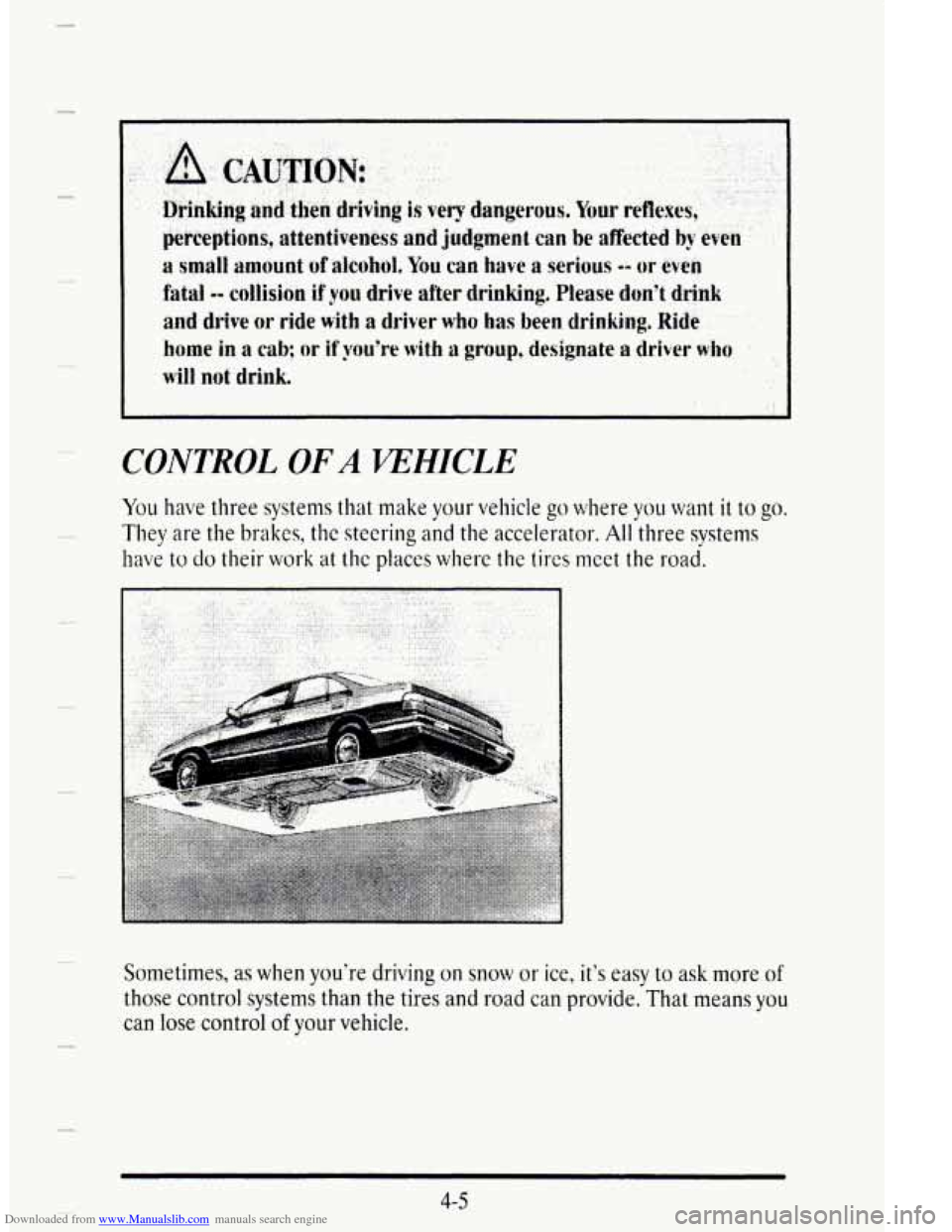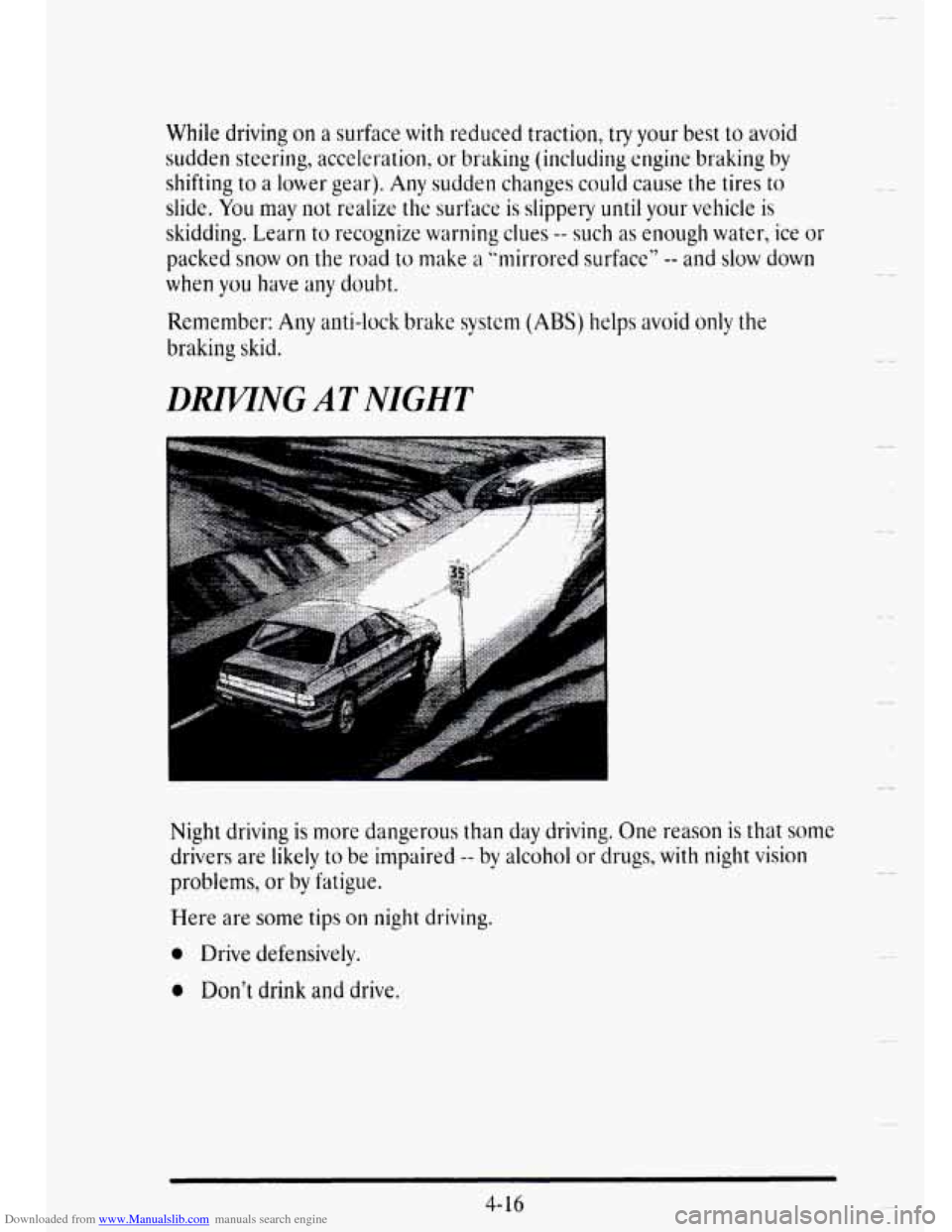1995 CADILLAC DEVILLE tires
[x] Cancel search: tiresPage 8 of 403

Downloaded from www.Manualslib.com manuals search engine P
r
! -7
I
For the 1948 model, Cadillac stainless steel roof and low profile
tires.
which set the rrend in automotive
styling
for nearly two decades. This
was followed by the 1949 model with
the two door hardtop Coupe DeVilIe
and the modern overhead valve,
high compression V8 engine.
.. ...
Engineering innovations, con-
veniences and styling dominated the
'50s and '60s. Cruise control, auto-
matic climate control,
tilt and
telescoping steering wheels, twilight
sentinel and four door hard tops
all
debuted in these years. In 1957 the
Eldorado Brougham featured
ad-
vances such as air suspension, mem-
ory seat, automatic electric door
locks, transistor radio,
a brushed
r- 19.53, was redesigned for 1967 as the
first front wheel drive personal lux-
ury car.
The 472 cu. in. V8 engine
used in all Cadillacs in 1968 and
1969 was enlarged to 500 cu. in. for
all 1970 Eldorados.
An Air Cushion Restraint
Sys-
tem (airbag) was available for 1974,
1975 and 1976 Cadillacs.
Analog Electronic Fuel Injec-
tion was available, on 1975 Cadillacs
and was standard on
the new inter-
national size
1976 Seville. In 1978,
the Trip Computer option incor-
porated an on-board microprocessor.
t
I
r
3 i
r
r:
r
Page 198 of 403

Downloaded from www.Manualslib.com manuals search engine CONTROL OF A WHICLE
You have three systenx that make your vehicle go where you want it to go.
They are the brakes, thc steering and the accelerator. All three systems
have to do their work at thc places where the tires meet the road.
Sometimes, as when you're driving
on snow or ice, it's easy to ask more of
those control systems than the tires and road can provide. That means you
can
lose control of your vehicle.
4-5
Page 204 of 403

Downloaded from www.Manualslib.com manuals search engine 3
Steering Tips
The traction vou can get in a CUI-VC depcnds on the condition of your tires
and the roaddsurfacc, the angle at which thc cun~ is banked, and your
speed. Whilc
you'rc in a curve, speed is the one factor you can control.
Suppose you're steering
through c a sharp curve. Then you suddenly
accelerate.
Both control systems -- stccring and acceleration -- have to do
their work where the tircs meet the road. Unless you have traction control
and the system is on, adding the sudden acceleration can demand too
muck of those places. You can lose control.
What should you
do if this ever happens'? Ease up on the accelerator
pedal, steer the vehicle the way you want it to go, and slow down.
Speed limit signs near curves warn that you should adjust your speed. Of
course, the posted speeds are based on good weather and road conditions.
Under less favorable conditions you'll want to go slower.
If you need to reduce your speed as you approach a curve, do it before
you enter the curve, while your front wheels are straight ahead.
Try to adjust your speed so you can "drive" through the curve. Maintain a
reasonable, steady speed. Wait to accelerate until you are out of the curve,
and then accelerate gently into the straightaway.
4-1 1
Page 208 of 403

Downloaded from www.Manualslib.com manuals search engine 0 Don't overtake a slowly moving vehicle too rapidly. Even though the
brake lamps are not flashing,
it may be slowing down or starting to turn,
0 If you're being passed, make it easv for the following driver to get
ahead
of you. Perhaps you can easi a little to the right.
LOSS OF CONTROL
Let's review what driving experts sav about what happens when the three
control svstems (brakes, steering an> acceleration)
don't have enough
friction where the tires meet the road to do what the driver has asked.
In any emergency, don't give up. Keep trying to steer and constantly seek
an escape route or area of less danger.
In a skid, a driver can lose control of the vehicle. Defensive drivers avoid
most skids
by taking reasonable care suited to existing conditions, and by
not "overdriving" those conditions.
But skids are always possible.
The three types of skids correspond to your Cadillac's three control
systems.
In the braking skid your wheels aren't rolling. In the steering or
cornering skid, too much speed or steering
in a curve causes tires to slip
and lose cornering force. And
in the acceleration skid too much throttle
causes
the driving wheels to spin.
A cornering skid is best handled by easing your foot off the accelerator
pedal.
Remember: Any traction control system helps avoid only the acceleration skid.
If your traction control system
is off? then an acceleration skid is also best
handled by easing your
foot off the accelerator pedal.
If your vehicle starts to slide, ease your foot off the accelerator pedal and
quickly steer
the way you want the vehicle to go. If you start steering
quickly enough, your vehicle may straighten out. Always be ready for a
second skid
if it occurs.
Of course, traction is reduced when water, snow, ice, gravel, or other material
is on the road. For safety, you'll want to slow down and adjust your driving to
these conditions. It is important to
slow down on slippery surfaces because
stopping distance will be longer and vehicle control more limited.
4-15
Page 209 of 403

Downloaded from www.Manualslib.com manuals search engine While driving on a surface with reduced traction, try Vour best to avoid
sudden steering, acceleration?
or braking (including engine braking by
shifting to a lower gear). Any sudden changes could cause the tires to
slide. You may not realize the surfdce is slippery until your vehicle is
skidding.
Leain to recognize warning clues -- such as enough water, ice or
packed snow on the road to make a “mirrored surface” -- and slow down
when
you have any doubt.
Remember:
Any anti-lock brake system (ABS) helps avoid only the
braking L. skid.
DRIVING AT NIGHT
Night driving is more dangerous than day driving. One reason is that some
drivers are likely to be impaired -- by alcohol or drugs, with night vision
problems,
or by fatigue.
Here are some tips on night driving.
0 Drive defensively.
0 Don’t drink and drive.
4-16
.I
Page 211 of 403

Downloaded from www.Manualslib.com manuals search engine DMNG IN THE RAIN
Rain and wet roads can mean driving trouble. On a wet road you can't
stop, accelerate or
turn as well because your tire-to-road traction isn't as
good as on dry roads. And, if your tires don't have much tread left, you'll
get even less traction. It's dwa~s wise to go slower and be cautious if rain
starts to fall while
you are driving. The surface may get wet suddenly when
your reflexes ;u'e tuned for driving on dry pavcment.
The heavier the rain, the harder it is to see. Even if your windshield wiper
blades are in
good shape, a heavy rain can make it harder to see road
signs and traffic signals, pavement markings, the edge of the road. and
cven peoplc walking.
It's wise to keep vour wiping quiptnent in good shape and keep your
windshield wash&
tank filled. Replace your windshield wiper inserts when
they show signs c. of streaking or missing areas on the windshield, or when
strips
of rubber start to separatc from the inserts.
3- 18
b4
Page 213 of 403

Downloaded from www.Manualslib.com manuals search engine Hydrupluning
Hydroplaning is dangerous. So much water can build up under your tires
that they can actually ride
on the water. This can happen if the road is wet
enough and you’re going fast enough. When your vehicle
is hydroplaning,
it has little or no contact with the road.
Hydroplaning doesn’t happen often. But it can if your tires haven‘t much
tread or
if the pressure in one or more is low. It can happen if a lot of
water
is standing on the road. If you can see reflections from trees,
telephone poles,
or other vehicles, and raindrops ‘‘dimple’‘ the water‘s
surface, there could be hydroplaning.
Hydroplaning
usually happens at higher speeds. There just isn‘t a hard
and fast
rule about hydroplaning. The best advice is to slow down when it
is raining.
Some Other Rainy Weather Tips
0 Turn on your low beam headlamps -- not just your parking lamps -- to
help
make you more visible to others.
Besides slowing down, allow some extra following distance. And be
especially careful when you pass another vehicle. Allow yourself more
clear
room ahead, and be prepared to have your view restricted by
road spray.
Have good tires with proper tread depth. (See “Tires” in the Index.)
4-20
Page 216 of 403

Downloaded from www.Manualslib.com manuals search engine Once you are moving on the freeway, make certain you allow a reasonable
following distance. Expect
to move slightly slower at night.
When
you want to leave the freeway, move to the proper lane well in
advance. If vou miss your exit do not, under any circumstances, stop and
back
up. Dr& on tolthe ncst exit.
The exit
ramp can be cuwed, sometimes quite sharply.
The exit
speed is usually posted.
BEFORE LEAUNG ON A LONG TRIP
Make sure vou're ready. Try to be well rested. If vou must start when
you're not iresh -- such as aftcr a day's work -- d6n.t plan to make too
many miles that first part of the journey. Wear comfortable clothing and
shoes
you can easily driw in.
Is vour vehicle ready for a long trip'! If you keep it stlnliced and
miintained, it's ready
to go. If it needs service, have it done before
starting
out. Of course, you'll find experienced and able service experts in
Cadillac dealerships all across North America. They'll be ready and
willing
to help if you need it.
Here are some things you can check before a trip:
Wirdd1ield Woslter Fluid: Is the reservoir full'? Are all windows clean
inside
and outside?
Tires: They are vitally important to a safe, trouble-free trip, Is the tread
good enough for long-distancc driving? Are thc tires all inflated to the
recornnxnded pressure'?
Should you
delay your trip a short time to avoid a major storm system'?
Weather Fomusts: What's the weather outlook along your route?
Mcq~s: Do you have up-to-date maps?
4-23